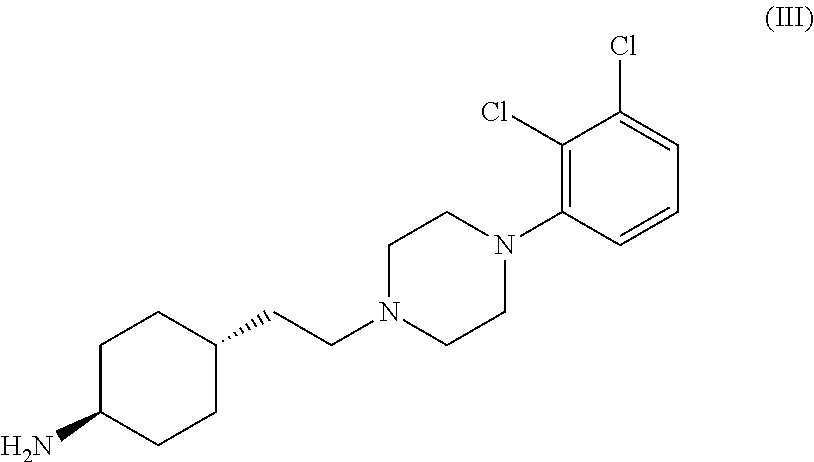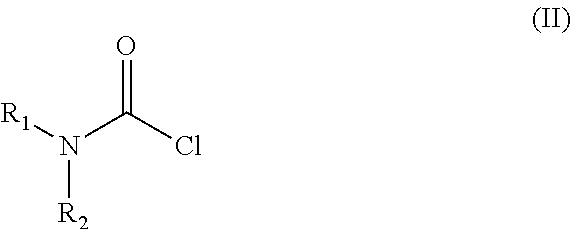Process for the preparation of piperazine derivatives
a technology of piperazine and derivatives, applied in the field of piperazine derivative preparation, can solve the problems of long reaction time (48 hours) and poor yield (65%)
- Summary
- Abstract
- Description
- Claims
- Application Information
AI Technical Summary
Benefits of technology
Problems solved by technology
Method used
Image
Examples
example 1
Preparation of trans 4-{2-[4-(2,3-dichlorophenyl)-piperazine-1-yl]-ethyl}-N,N-dimethylcarbamoyl-cyclohexylamine
[0029]Into a 500 ml four-necked flask 180 ml of dichloromethane, 40 ml of 40% sodium hydroxide, 0.54 g (0.002 mol) of tetra-n-butylammonium bromide and 3.12 g (0.029 mol) of N,N-dimethylcarbamoylchloride are added. The mixture is stirred at a temperature between 20-25° C. for 30 minutes then 6.24 g (0.0145 mol) of trans 4-{2-[4-(2,3-dichlorophenyl)-piperazine-1-yl]-ethyl}-cyclohexyl amine dihydrochloride is added. With rigorous stirring the reaction mixture is placed into an oil bath preheated to 45-50° C. and heated to boiling temperature under nitrogen for 10 hours. Then the reaction mixture is cooled to room temperature, the phases are separated and the organic layer is washed with 3×80 ml of water and then 80 ml of 10% sodium chloride solution. The solvent is removed under vacuum; the residue obtained is further dried at maximum 50° C. temperature, until its weight is c...
example 2
Preparation of trans 4-{2-[4-(2,3-dichlorophenyl)-piperazine-1-yl]-ethyl}-N,N-dimethylcarbamoyl-cyclohexylamine
[0030]Into a 500 ml four-necked flask 180 ml of dichloromethane, 40 ml of 40% sodium hydroxide, 0.54 g (0.002 mol) of tetra-n-butylammonium bromide and 3.12 g (0.029 mol) of N,N-dimethylcarbamoyl chloride are added. The mixture is stirred at a temperature between 20-25° C. for 30 minutes then 6.50 g (0.0145 mol) of trans 4-{2-[4-(2,3-dichlorophenyl)-piperazine-1-yl]-ethyl}-cyclohexyl amine dihydrochloride monohydrate is added. With rigorous stirring the reaction mixture is placed into an oil bath preheated to 45-50° C. and heated to boiling temperature under nitrogen for 10 hours. Then the reaction mixture is cooled to room temperature, the phases are separated and the organic layer is washed with 3×80 ml of water and then 80 ml of 10% sodium chloride solution. The solvent is removed under vacuum; the residue obtained is further dried at maximum 50° C. temperature, until it...
example 3
Preparation of trans N-{4-{2-[4-(2,3-dichlorophenyl)-piperazine-1-yl]-ethyl}-cyclohexyl}-morpholine-4-carbonic acid amide
[0031]Into a 500 ml four-necked flask 400 ml of dichloromethane, 40 ml of 40% sodium hydroxide, 1.2 g (0.0036 mol) of tetra-n-butylammonium bromide and 11 g (0.074 mol) of N,N-dimethyl carbamoyl chloride are added. The mixture is stirred at a temperature between 20-25° C. for 30 minutes then 15.5 g (0.036 mol) of trans 4-{2-[4-(2,3-dichlorophenyl)-piperazine-1-yl]-ethyl}-cyclohexyl amine dihydrochloride is added. With rigorous stirring the reaction mixture is placed into an oil bath preheated to 45-50° C. and heated to boiling temperature under nitrogen for 4 hours. Then the reaction mixture is cooled to room temperature, the phases are separated and the organic layer is washed with 3×80 ml of water and then 150 ml of 10% sodium chloride solution. The solvent is removed under vacuum; the residue obtained is further dried at maximum 50° C. temperature, until its we...
PUM
| Property | Measurement | Unit |
|---|---|---|
| temperature | aaaaa | aaaaa |
| temperature | aaaaa | aaaaa |
| boiling temperature | aaaaa | aaaaa |
Abstract
Description
Claims
Application Information
 Login to View More
Login to View More - R&D
- Intellectual Property
- Life Sciences
- Materials
- Tech Scout
- Unparalleled Data Quality
- Higher Quality Content
- 60% Fewer Hallucinations
Browse by: Latest US Patents, China's latest patents, Technical Efficacy Thesaurus, Application Domain, Technology Topic, Popular Technical Reports.
© 2025 PatSnap. All rights reserved.Legal|Privacy policy|Modern Slavery Act Transparency Statement|Sitemap|About US| Contact US: help@patsnap.com



